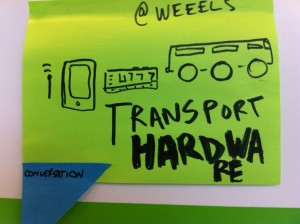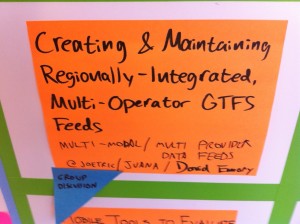

TransportationCamp provides an opportunity for every single attendee to be a participant in shaping and leading the event. Curious about how this will work? Read on for everything you need to know, including the process for proposing sessions, making your session appealing and how to pick and choose which sessions to attend on the day.

Transportation is an "unconference", not a conference. Rather than giving you the attendee a list of sessions to pick from, the sessions are programmed and led by the attendees. Unconferences are popular in the tech world because they reflect the culture of the industry—hands-on, flexible, a little casual but very hard-working. And usually, really fun.
All sessions are open for attendees to define, describe, and lead. Session can take almost any form and can be about almost any topic, fun or serious. You can run your own, or indicate that you’re looking for collaborators. Possible formats include: a slide presentation followed by Q&A, a panel discussion you have organized, a wide-open brainstorm, or any other arrangement of your design. It's important to make your chosen format clear, so that participants know what to expect ahead of time.
Unconference sessions have a lot of energy, and flexibility. But occasionally, they can be a bit frustrating. Here are some tips:
Remember the Rule of Two Feet: If you don't feel like you're engaged or the session was not what you expected, you're free to walk out, and find a session that fits you better. Don't stay in a session that doesn't work for you, move to another session that needs your contributions. If you're running a session, don't be offended if people walk out, either.
Speak up: if a session needs help, provide it. Feel free to give reminders about time or topic focus.
Do it yourself! If you want a session to be different, maybe more technical, or more policy focused, suggest it! Other people might feel the same way, and you'll help to sharpen the focus for everyone.
Good stuff happens outside of sessions too. Unscheduled, informal conversations in the hallways or at lunch are great for continuing off-shoots from sessions.
“The Board” is the central nervous system of the event. It's a grid, representing the available spaces (the rows) and planned time slots (the columns). Each box is a particular space at a particular time, the sticky note in each grid cell describes what the session will be, including topic, format and presenter.
When the day starts, the board will usually be empty. At some events, organizers will solicit session proposals from attendees beforehand, but at most, all sessions are planned day-of. In the unconference tradition, participants propose sessions by writing them up (as described below) on large sticky notes. Then, an event organizer puts the session into a space on the board. We will try to spread sessions across the day evenly, making sure that similar or complementary sessions don’t go head to head.
Use the Board to plan your day. Once individual sessions are up on the board, it's unlikely they will move around, but double-check just to be safe. Most Camps will also maintain an online version of the board, so you can also check the latest status of the board from your laptop or phone.
Show up at TransportationCamp with your session in mind, or be inspired in the morning as participants introduce themselves. Grab a sticky note and describe your session—don’t be shy about it! You are interesting and your work is compelling and people will want to hear what you have to share. Your note must include:
It helps if your sticky note is compelling (not just legible). If you have any time or equipment restrictions, indicate them on the back of the sticky. Here are a couple of great examples:


Give your session to the Board organizer. To start with, we'll put your sticky to one side, then we'll start scheduling the sessions once a critical mass of session proposals builds up. Each blank square in the board grid represents a session period in a particular room. When the session get scheduled, your sticky will move into a box on the board, representing a room and a time.
Throughout the day, keep an eye on the physical or online versions of the board to plan which sessions you attend.
Sometimes we need to merge your session with someone else's. Often, it's because you and someone else independently proposed a session on a particular topic. If possible, we will try to find both of you and talk it over first. Merging doesn't work so well if you both want to present on the topic, but it's great if you're both looking for a discussion. If you do agree to merge, work out who will provide the leadership needed to keep the session on track.
So, you proposed a fantastic session and it's up on the board. Congratulations! You're responsible for the session logistics and content, here are some tips for making the most of the session: